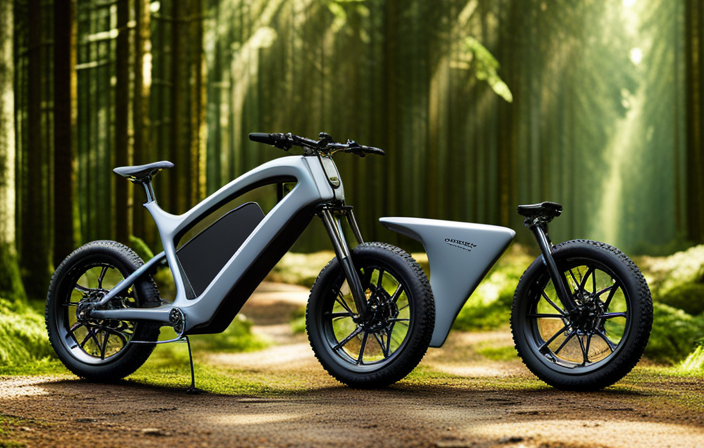As a passionate electric bike enthusiast, I can’t help but wonder, how long does an electric bike battery actually last? It’s a question that many riders like myself ponder, as we rely on these batteries to power our two-wheeled adventures.
In this article, I will dive deep into the world of electric bike batteries, exploring the different types, factors that affect their lifespan, and how to maximize their longevity.
So, hop on and let’s embark on this electrifying journey together!
Key Takeaways
- Electric bike batteries have varying lifespans depending on the type, with lead acid and nickel cadmium batteries lasting 2-3 years, while lithium-ion batteries last 5-7 years.
- Proper charging and maintenance, including following the manufacturer’s instructions, charging fully before each use, and storing the battery in a cool and dry place, can maximize battery lifespan.
- Factors such as temperature, charging cycle, and riding habits can affect the battery lifespan, so it’s important to be mindful of these factors to maximize efficiency and longevity.
- Regular cleaning, inspection, and recognizing signs of declining battery, such as decreased range or slower charging time, can help prevent performance issues and indicate when the battery may need to be replaced.
Understanding Electric Bike Batteries
Electric bike batteries are a crucial component in determining how long an electric bike can last on one charge. Proper electric bike battery charging and maintenance are essential for maximizing the lifespan and performance of these batteries.
When it comes to charging an electric bike battery, it is important to follow the manufacturer’s instructions. Typically, this involves plugging the charger into a standard electrical outlet and connecting it to the battery. It is recommended to charge the battery fully before each use to ensure maximum range.
Regular electric bike battery maintenance is also important for optimal performance. This includes keeping the battery clean and dry, as moisture can cause damage. It is also important to store the battery in a cool and dry place when not in use.
In addition to charging and maintenance, it is important to be mindful of certain factors that can affect the lifespan of an electric bike battery. Extreme temperatures, both hot and cold, can impact battery performance. It is best to avoid exposing the battery to such conditions.
Understanding electric bike battery charging and maintenance is crucial for maximizing the lifespan and performance of these batteries. Now, let’s explore the different types of electric bike batteries and their characteristics.
Types of Electric Bike Batteries
When it comes to the types of batteries for your e-bike, you should consider the lifespan and performance of each option. There are several types of batteries commonly used in electric bikes, each with its own pros and cons. Let’s take a closer look at these options in the table below:
| Battery Type | Lifespan | Performance |
|---|---|---|
| Lead Acid | 2-3 years | Low |
| Nickel Cadmium | 2-3 years | Medium |
| Lithium-ion | 5-7 years | High |
Table: Types of Electric Bike Batteries
Battery charging and maintenance play a crucial role in extending the lifespan of your e-bike battery. Regularly charging your battery after each ride helps maintain its overall health and performance. It is important to follow the manufacturer’s instructions for charging the battery and avoid overcharging or undercharging it. Additionally, storing your battery in a cool and dry place when not in use can also help prolong its lifespan.
Understanding the different types of batteries and implementing proper charging and maintenance practices can significantly impact the lifespan of your e-bike battery. By taking these steps, you can ensure that your battery lasts as long as possible, allowing you to enjoy many worry-free rides. Now, let’s explore the factors that can affect the lifespan of your e-bike battery.
Factors Affecting Battery Lifespan
Proper charging and maintenance practices can significantly impact how long your e-bike battery will continue to function effectively. There are several factors that can affect the lifespan of your electric bike battery, and understanding these factors is crucial for maximizing battery efficiency.
One of the main factors affecting battery performance is temperature. Extreme cold or hot temperatures can reduce the battery’s capacity and overall lifespan. It is important to store and charge your battery in a moderate temperature environment to avoid any potential damage.
Another factor to consider is the charging cycle. Each time you charge your battery, it goes through a cycle, and over time, this cycle can degrade the battery’s performance. It is recommended to avoid overcharging or letting the battery fully drain before recharging. Instead, try to keep the battery charge level between 20% and 80% for optimal performance.
Additionally, the way you ride your e-bike can also impact battery lifespan. Factors such as speed, terrain, and load can affect how much power the battery consumes. Riding at high speeds or on steep hills will drain the battery faster, so it is important to be mindful of your riding habits and adjust accordingly.
In conclusion, by taking into account factors such as temperature, charging cycles, and riding habits, you can maximize the efficiency and lifespan of your e-bike battery. Understanding these factors will help you get the most out of your battery while enjoying a longer-lasting and more reliable electric bike.
Transition: Now that we have discussed the factors that affect battery lifespan, let’s move on to the next section about the average lifespan of electric bike batteries.
Average Lifespan of Electric Bike Batteries
Transitioning to the average lifespan of e-bike batteries, it’s important to consider various factors that influence how long they will remain functional. Battery maintenance and charging habits play a crucial role in determining the longevity of these batteries. Let’s delve into the details.
| Factors Influencing Lifespan | Description |
|---|---|
| Battery Maintenance | Regularly cleaning and inspecting the battery can prevent dirt and debris buildup, which can affect its performance. Additionally, ensuring that the battery is properly secured in its housing can minimize vibrations and potential damage. |
| Charging Habits | Proper charging habits are essential for prolonging the lifespan of e-bike batteries. Overcharging or undercharging can lead to decreased battery capacity and overall performance. It’s best to follow the manufacturer’s guidelines for charging duration and frequency. Avoid leaving the battery connected to the charger for extended periods when it’s already fully charged. |
Signs of a Declining Battery
By practicing good maintenance and following appropriate charging habits, you can maximize the lifespan of your e-bike battery. However, even with the best care, batteries will eventually start to show signs of decline.
It’s important to recognize these warning signs so that you can address any issues promptly. One of the most common indicators is a decrease in range. If you notice that your e-bike can no longer travel as far on a single charge as it used to, it may be a sign that your battery is losing capacity.
Another warning sign is a slower charging time. If your battery takes significantly longer to charge than it did before, it could be a sign of internal damage. Additionally, if you experience frequent power cut-offs or if your battery gets unusually hot during rides, it’s time to take action.
Regular maintenance can help prevent these issues, such as cleaning and inspecting the battery regularly, storing it in a cool and dry place, and avoiding overcharging.
Tips for Extending Battery Life
To maximize the lifespan of your e-bike battery, it’s important to implement these tips for extending its life:
-
Charge your battery properly: Always follow the manufacturer’s instructions for charging your e-bike battery. Overcharging or undercharging can reduce its lifespan.
-
Avoid extreme temperatures: Exposing your battery to extreme heat or cold can negatively affect its performance. Store your e-bike in a cool, dry place and avoid leaving it in direct sunlight.
-
Use the right power level: Adjust your e-bike’s power level according to your needs. Using a higher power level than necessary can drain the battery faster.
-
Maintain proper tire inflation: Keeping your tires properly inflated not only improves your ride, but it also reduces the strain on the battery. Low tire pressure can increase rolling resistance and drain the battery more quickly.
-
Pedal when possible: While e-bikes are designed to provide assistance, pedaling when possible can help extend the battery life. By sharing the workload with the motor, you can maximize the distance you can travel on a single charge.
By following these tips, you can extend the life of your e-bike battery and maximize its performance.
However, if your battery reaches the end of its lifespan and requires replacement, there are various battery replacement options available.
Battery Replacement Options
If your e-bike battery needs to be replaced, there are several options available.
The first thing you should check is the battery warranty. Most reputable e-bike manufacturers offer warranties on their batteries, ranging from one to three years. If your battery fails within the warranty period, you can contact the manufacturer for a replacement. However, if the warranty has expired or doesn’t cover the issue you’re facing, you still have a few choices.
One option is to purchase a new battery from the manufacturer or an authorized dealer. This ensures that you get a battery that is compatible with your e-bike model and meets the required specifications. Another option is to consider aftermarket batteries. These are batteries made by third-party manufacturers that are designed to work with a variety of e-bike models. Before purchasing an aftermarket battery, make sure to check its compatibility and reviews from other users.
In order to prolong the lifespan of your new battery, it’s important to follow proper battery maintenance practices. This includes charging the battery correctly, avoiding extreme temperatures, and storing it in a cool, dry place when not in use. Regularly cleaning the battery terminals and keeping them free from corrosion can also help maintain the battery’s performance.
Now, let’s move on to the next topic: recycling and disposal of electric bike batteries.
Recycling and Disposal of Electric Bike Batteries
After exploring the various options for replacing electric bike batteries, it is important to consider the recycling and disposal of these batteries. As electric bikes continue to grow in popularity, the number of batteries being used and eventually discarded is also increasing. This poses significant challenges in terms of recycling and minimizing the environmental impact.
To highlight the importance of proper recycling and disposal, let’s take a closer look at the environmental impact of electric bike batteries. These batteries typically contain heavy metals such as lead, cadmium, and lithium, which can be harmful to the environment if not handled correctly. Improper disposal can lead to soil and water contamination, which can have detrimental effects on ecosystems.
To emphasize the need for responsible battery disposal, consider the following table:
| Recycling Challenges | Environmental Impact | Solutions |
|---|---|---|
| Lack of awareness about recycling options | Soil and water contamination | Implementing educational campaigns to raise awareness |
| Limited recycling infrastructure and facilities | Harmful effects on ecosystems | Expanding recycling facilities and incentivizing battery recycling |
| Low recycling rates | Resource depletion | Encouraging consumers to return used batteries to retailers or manufacturers |
Proper recycling and disposal of electric bike batteries is crucial to mitigate the environmental impact and ensure the sustainability of this growing industry. By taking responsibility for our battery waste, we can contribute to a cleaner and healthier planet.
Now, let’s transition into the subsequent section about upgrading your electric bike battery.
Upgrading Your Electric Bike Battery
When considering upgrading, you should evaluate the capacity and compatibility of the new battery with your electric bike. Battery maintenance and performance are crucial factors to consider when choosing a new battery. Here are some important points to keep in mind:
-
Capacity: The capacity of a battery determines how far you can go on a single charge. A higher capacity battery will allow for longer rides without needing to recharge. Imagine effortlessly cruising through scenic routes, exploring new trails, and enjoying extended rides without worrying about running out of power.
-
Compatibility: Ensure that the new battery is compatible with your electric bike’s specifications. It should fit properly and connect seamlessly. Picture a battery that seamlessly integrates into your electric bike, providing optimal performance and enhancing your overall riding experience.
-
Battery life: Consider the longevity of the battery. A high-quality battery will have a longer lifespan and require less frequent replacements. Imagine the peace of mind knowing that your battery will last for years, allowing you to enjoy countless adventures on your electric bike.
Upgrading your electric bike battery can greatly enhance your riding experience, but it’s important to weigh the pros and cons of different battery capacities.
Pros and Cons of Different Battery Capacities
Consider the distance you want to travel on a single charge, as different battery capacities offer varying ranges for your electric bike rides. When it comes to electric bikes, the battery is a crucial component that determines how far you can go before needing to recharge. The capacity of the battery is measured in watt-hours (Wh), and generally, the higher the watt-hour rating, the longer the battery will last.
Battery charging and maintenance are essential factors to consider when choosing a battery capacity. Higher-capacity batteries typically take longer to charge, so if you’re someone who needs to recharge quickly, a lower-capacity battery might be more suitable. Additionally, it’s important to follow proper battery maintenance practices to ensure optimal performance and longevity. Regularly inspecting the battery for any signs of damage or wear, cleaning the contacts, and storing it in a cool and dry place when not in use can help extend its lifespan.
In conclusion, the pros and cons of different battery capacities for electric bikes revolve around the distance you want to travel on a single charge, charging time, and battery maintenance. Understanding your specific needs and preferences will guide you in choosing the right battery capacity for your electric bike.
Now, let’s delve into the next section, where we will explore battery range and power output.
Battery Range and Power Output
In my previous discussion, I explored the pros and cons of different battery capacities for electric bikes. Now, let’s delve into the topic of battery range and power output. The battery range refers to the distance an electric bike can travel on a single charge. This is a crucial factor to consider when choosing an electric bike, as it determines how far you can go without needing to recharge.
The battery range is influenced by various factors, including the battery capacity, the power output of the motor, and the efficiency of the bike’s components. To give you a better understanding, let’s take a look at the impact of temperature on battery performance:
| Temperature | Effect on Battery Performance |
|---|---|
| Hot | Decreased range and lifespan |
| Cold | Decreased range and power output |
As shown in the table above, extreme temperatures can significantly affect the performance of your electric bike’s battery. It’s important to note that cold temperatures can cause the battery to discharge more quickly, resulting in reduced range and power output. On the other hand, hot temperatures can lead to decreased battery lifespan and reduced range.
Understanding the impact of temperature on battery performance is crucial for maximizing the range of your electric bike. In the next section, I will discuss how to calculate battery range without relying on a step-by-step approach.
How to Calculate Battery Range
To calculate your battery range, you’ll need to take into account factors such as the energy capacity, power consumption, and efficiency of your electric bike. Battery efficiency refers to how effectively your battery converts stored energy into power for your electric bike. Maximizing battery range requires understanding how these factors work together.
Firstly, energy capacity is the amount of energy your battery can store. This is usually measured in watt-hours (Wh). To estimate your battery range, divide the energy capacity by the average power consumption of your electric bike. For example, if your battery has an energy capacity of 500Wh and your bike consumes an average of 20W, your battery range would be 25 hours.
Secondly, power consumption is the rate at which your electric bike uses energy. This can vary depending on factors such as terrain, speed, and rider weight. To maximize battery range, ride at a consistent speed, avoid rapid acceleration, and choose the most efficient power assist level for your needs.
Lastly, battery efficiency plays a significant role in determining your battery range. Higher efficiency means less energy is wasted during the conversion process. Regular maintenance, such as keeping your battery clean and storing it in a cool, dry place, can help maintain its efficiency.
By calculating battery efficiency and considering factors like energy capacity and power consumption, you can maximize your electric bike’s battery range.
Now, let’s explore some important electric bike battery safety tips.
Electric Bike Battery Safety Tips
One important tip for safely using an electric bike battery is to regularly inspect it for any signs of damage or wear. This is crucial for ensuring the longevity and performance of your battery.
Here are some key points to consider when it comes to electric bike battery charging and maintenance:
-
Proper charging: Always use the charger provided by the manufacturer to charge your electric bike battery. Avoid using incompatible chargers, as they can cause damage to the battery or even pose a safety risk.
-
Avoid overcharging: Overcharging can lead to decreased battery life and potential safety hazards. It is important to unplug the charger once the battery is fully charged. Some electric bike batteries come with built-in protection mechanisms to prevent overcharging, but it’s still a good practice to unplug the charger in a timely manner.
-
Regular cleaning and maintenance: Keep your electric bike battery clean and free from dirt, dust, and debris. Use a soft, damp cloth to wipe the battery casing and connectors. Avoid using harsh chemicals or abrasive materials that could damage the battery.
Taking these precautions will help ensure the safety and longevity of your electric bike battery.
Now, let’s move on to discussing the best practices for storing your electric bike battery.
Best Practices for Storing Your Electric Bike Battery
A key tip for safely storing your e-bike battery is to keep it in a cool and dry place to prevent damage or deterioration. The storage temperature plays a crucial role in maintaining the lifespan of your battery. Extreme heat or cold can negatively impact the performance and longevity of the battery. Ideally, you should store your e-bike battery in a temperature-controlled environment, such as a garage or shed, where the temperature stays within the recommended range.
In addition to the storage temperature, charging frequency is another factor to consider when storing your e-bike battery. It is essential to keep your battery charged at around 50-80%. Storing the battery with a full charge or completely drained can lead to capacity loss over time. If you won’t be using your e-bike for an extended period, it is recommended to charge the battery to around 50% and then store it in a cool and dry place.
Conclusion: Making the Most of Your Electric Bike Battery
By following these guidelines, you can maximize the performance and lifespan of your e-bike battery.
Proper battery maintenance is crucial to ensure that your electric bike battery performs at its best for as long as possible.
One important aspect of battery maintenance is to avoid overcharging. Overcharging can lead to decreased battery performance and a shorter lifespan. To prevent this, make sure to unplug your battery as soon as it reaches full charge.
Additionally, it is important to store your battery in a cool and dry place, away from extreme temperatures and humidity. This will help to preserve the battery’s capacity and overall performance.
Another tip for maximizing battery performance is to avoid fully draining the battery before recharging it. Instead, aim to recharge your battery when it reaches around 20-30% capacity. This will help to extend the overall lifespan of the battery.
Lastly, regular cleaning and inspection of the battery terminals can also help to improve battery performance.
Frequently Asked Questions
Are there any safety tips or precautions to keep in mind when using an electric bike battery?
When it comes to electric bike battery maintenance, there are a few safety tips and precautions to keep in mind. It’s important to avoid overcharging or exposing the battery to extreme temperatures, as these can lead to common issues with electric bike batteries.
What are some best practices for storing an electric bike battery when not in use?
When it comes to storing an electric bike battery, there are a few best practices to keep in mind. First, choose a cool and dry location for storage. Second, periodically charge the battery to maintain its health. These storage options and battery maintenance tips will help prolong the lifespan of your electric bike battery.
Can I upgrade my electric bike battery to increase its lifespan or performance?
Yes, you can upgrade your electric bike battery to increase its lifespan and performance. By investing in a higher capacity battery or a more advanced technology, you can enjoy longer rides and improved overall performance.
Are there any options for recycling or disposing of electric bike batteries responsibly?
When it comes to electric bike batteries, it’s important to consider responsible disposal and recycling options. There are several organizations and retailers that offer programs for safely disposing of and recycling electric bike batteries, ensuring they are handled in an environmentally friendly manner.
How do I calculate the battery range of my electric bike before purchasing it?
To calculate the battery range of an electric bike, consider factors like battery capacity, motor power, rider weight, terrain, and assist level. These factors affect how far you can ride before needing to recharge the battery.
Conclusion
After delving into the world of electric bike batteries, it’s clear that these power sources are essential for a smooth and enjoyable ride.
With an average lifespan of two to four years, it’s crucial to take proper care of your battery to maximize its longevity.
Interestingly, research shows that the lifespan of an electric bike battery can be extended by up to 30% when stored in a cool environment.
So, remember to find a cool spot for your battery to ensure it lasts even longer.
Happy riding!









